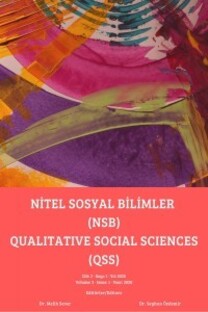Who am I in my story of teaching?: Confronting puzzle of practice through narrative inquiry
anlatı sorgulaması, içsel sorgulama, öğrenci merkezli öğrenme, yükseköğretim
Who am I in my story of teaching?: Confronting puzzle of practice through narrative inquiry
Narrative inquiry reflexivity, transformative learning, student centred learning, higher education,
___
- Boud, D., Cohen, R., & Walker, D. (1993). Introduction: Understanding learning from experience. In D. Boud, R. Cohen & D. Walker (Eds.), Using Experience for Learning (pp. 1-17). The Society for Research into Higher Education & Open University Press.
- Brookfield, S. D. (1995). Becoming a Critically Reflective Teacher. John Wiley & Sons.
- Brookfield, S. D. (2000). Transformative learning as ideology critique. In J. Mezirow & Associates (Eds.), Learning As Transformation: Critical Perspectives On A Theory In Progress (pp. 125-150). Jossey-Bass.
- Connelly, F. M., & Clandinin, D. J. (1988). Teachers as curriculum planners: Narratives of experience. University of Columbia.
- Connelly, F. M., & Clandinin, D. J. (1999). Knowledge, context, and identity. In F.M. Connelly & D.J. Clandinin (Eds.), Shaping A Professional Identity: Stories of Educational Practice (1-8). Columbia University.
- Etherington, K. (2004). Becoming a Reflexive Researcher: Using Our Selves in Research. Jessica Kingsley Publishers.
- Khairiyah Mohd. Yusof, Mohd. Kamaruddin Abd. Hamid, Mohd. Ariffin Abu Hassan, Mimi Haryani Hassim, Syed Ahmad Helmi Syed Hassan & Zaidatun Tasir (2005a). Outcomes of Problem-Based Learning (PBL) Implementation from Students’ Perspectives. Paper presented at the Proceedings of the 2005 Regional Conference on Engineering Education, December 12-13, 2005.
- Khairiyah Mohd. Yusof, Zaidatun Tasir, Jamalludin Harun & Syed Ahmad Helmi (2005b). Promoting problem-based learning (PBL) in engineering courses at the Universiti Teknologi Malaysia. Global Journal of Engineering Education, 9(2), 175-184.
- Kreber, C. (2001). Learning experientially through case studies? A conceptual analysis. Teaching in Higher Education, 6(2), 217-228.
- Kreber, C., & Cranton, P. A. (2000). Exploring the scholarship of teaching. The Journal of Higher Education, 71(4), 476-495.
- Kozhevnikov, M., Hegarty, M., & Mayer, R. E. (2002). Revising the visualizer-verbalizer dimension: evidence for two types of visualizers. Cognition and Instruction, 20(1), 47-77.
- Lim, K.H.. (2003a). Budi as the Malay mind. IIAS Newsletter, 31(July), 31.
- Lim, K. H. (2003b). Budi as the Malay mind: A philosophical study of Malay ways of reasoning and emotion in peribahasa. University of Hamburg, Hamburg Germany.
- Lindblom-Ylanne, S., Trigwell, K., Nevgi, A., & Ashwin, P. (2006). How approaches to teaching are affected by discipline and teaching context. Studies in Higher Education, 31(3), 285-298.
- Mayer, R. E., & Massa, L. J. (2003). Three facets of visual and verbal learners: cognitive ability, cognitive style, and learning preference. Journal of Educational Psychology, 95(4), 833-846.
- Mezirow, J. (1997). Transformative learning: theory to practice. New Directions for Adult and Continuing Education, (74), 5-12.
- Mezirow, J. (2000). Learning to think like an adult: core concepts of transformation theory. In J.Mezirow & Associates (Eds.), Learning As Transformation: Critical Perspectives On A Theory In Progress (3-33). Jossey-Bass.
- Mezirow, J. (2003). Transformative learning as discourse. Journal of Transformative Education, 1(58), 58-63.
- Moon, J.A. (2006). Learning Journals: A Handbook for Reflective Practice and Professional Development. Routledge.
- Niemi, H. (2002). Active learning - a cultural change needed in teacher education and schools. Teaching and Teacher Education, 18, 763-780.
- Ramsden, P. (2003). Learning to Teach in Higher Education (2 ed.). RoutledgeFalmer.
- Russel, T., & Munby, H. (1991). Reframing: the role of experience in developing teachers’ professional knowledge. In D. A. Schon (Ed.), The Reflective Turn: Case Studies In and On Educational Practice (164-187). New York: Teachers College: Columbia University.
- Samah, N. A. (2011). Seeing with new eyes: insights from an inquisitive journey. In S. Trahar (Ed.), The Doctorate: International Stories Of The UK Experience (63-69). EsCalate.
- Samah, N. A. (2012). Embracing practitioner research in higher education: a story from a doctoral journey. In Lokman Mohd. Tahir & Hamdan Said (Eds.), Educational İssues, Research and Policies (153-174). Penerbit UTM Press.
- Samah, N. A. (2013). Seeing with new eyes: becoming a narrative inquirer in higher education practice. In S. Trahar (Ed.), Contextualising Narrative Inquiry: Developing Methodological Approaches for Local Contexts (89-107). Routledge.
- Samah, N. A. (2018). Battling bad weather along the way: Meaning making in narrative inquiry and its challenges. International Journal of Business & Society. 19(2), 205-218.
- Ujang, Z. (2009). Mewarisi Perjuangan, Menjayakan Transformasi, Memacu Kegemilangan (Siri Perutusan Naib Canselor). Penerbit UTM Press.
- Yayın Aralığı: Yılda 2 Sayı
- Başlangıç: 2019
- Yayıncı: Melih SEVER
Gömülü Teori Yaklaşımının Yönetim Araştırmalarında Kullanımı
Karanlık Liderlik Ölçeği: Çalışanların Algısı Üzerine Bir Ölçeklendirme Çalışması
Mine M. AFACAN FINDIKLI, Gözde OKAN, Ünsal SIĞRI
Who am I in my story of teaching?: Confronting puzzle of practice through narrative inquiry
Akademide Dedikodu ve Söylenti Ağı Üzerine Nitel Bir Çalışma
